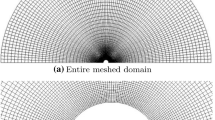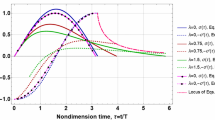Abstract
A ballistic limit curve for hypervelocity impact of spherical aluminum projectiles on a single wall aluminum plate is examined using the smooth particle hydrodynamics (SPH) method. A brief description is provided about a new in-house code with an emphasis on the axi-symmetric coordinate scheme. The Benchmark Taylor bar impact test was first demonstrated as a validation of the code. Then a series of hypervelocity impact simulations was performed in axi-symmetric coordinate. The impact velocity ranged from 2 km/s to 10 km/s. The plate thickness varied from 2 mm to 8 mm. The ballistic limit results calculated are compared with predictions from empirical correlations, and the results are shown to fall within the envelope of the empirical correlation. A simple theory is developed to analyze the characteristics of ballistic limit curves. The theory provides a good insight on the hypervelocity plate impact event and is valuable for design concerns.
Similar content being viewed by others
References
Y. G. Angel and J. P. Smith, Critical response of shielded plates subjected to hypervelocity impact, Int. J. of Impact Engng., 14 (1993) 25–35.
R. Kinslow, High-velocity impact phenomena, Academic Press, New York, 1970.
J. A. Zukas, T. Nicholas, H. F. Swift and D. R. Curran, Impact dynamics, Wiley, New York, 1982.
B. G. Cour-Palas and J. L. Crews, A multi-shock concept for spacecraft shielding, Int. J. of Impact Engng., 10 (1990) 135–146.
A. J. Piekutowski, Characteristics of debris clouds produced by hypervelocity impact of aluminum spheres with thin aluminum plates, Int. J. of Impact Engng., 14 (1993) 573–586.
K. A. Holsapple and R. M. Schmidt, On the scaling of crater dimensions 2 impact process, Journal of Geophysical Research, N87, B3 (1982).
B. G. Cour-Palais, Hypervelocity impact investigations and meteoroid shielding related to apollo and skylab, NASA-S-82-05009, September, 1984.
K. B. Hayashida and J. H. Robinson, Single wall penetration equations, NASA TM-103565, December, 1991.
L. B. Lucy, A numerical approach to the testing of the fission hypothesis, The Astro. J., 82 (1977) 1013–1024.
R. A. Gingold and J. J. Monaghan, Smoothed particle hydrodynamics: Theory and application to non-spherical stars, Monthly Notices Royal Astr. Soc., 181 (1977) 375–389.
L. D. Libersky and A. G. Petschek, Smooth particle hydrodynamics with strength of material, In Advances in the Free-Lagrange Method, Lecture Notes in Physics, 395, Springer, 1990.
G. R. Johnson, E. H. Petersen and R. A. Stryk, Incorporation of an SPH Option into the EPIC code for a wide range of high velocity impact computations, Int. J. Impact Engng. 14(1) (1993) 385–394.
G. R. Johnson, R. A. Stryk and S. R. Beissel, SPH for high velocity impact computations, Comput. Methods Appl. Mech. Engng., 139 (1996) 347–373.
C. J. Hayhurst and R. Clegg, Cylindrically symmetric SPH simulations of hypervelocity impacts on thin plates, Int. J. Impact Engng., 20 (1997) 337–348.
C. E. Anderson, D. L. Littlefield and J. D. Walker, Longrod penetration, Target Resistance, and Hypervelocity Impact, Int. J. of Impact Engng., 14 (1993) 1–12.
G. R. Johnson and W. H. Cook, Fracture characteristics of three metals subjected to various strains, strain rates, Temperature, Pressure, Engng. Fracture Mech., 21(1) (1985) 31–48.
R. L. Woodward and S. J. Cimpoeru, A study of the perforation of aluminum laminate targets, Int. J. of Impact Engng., 21(3) (1998) 117–131.
Author information
Authors and Affiliations
Corresponding author
Additional information
This paper was recommended for publication in revised form by Associate Editor Jeonghoon Yoo
Minhyung Lee, a professor in the Mechanical Engineering at Sejong University, Seoul, Korea, holds a Ph.D from the University of Texas at Austin. His research interests include Lagrangian, Multi-material Eulerian and arbitrary Lagrangian-Eulerian (ALE) finite element methods for high strain rate of large deformation problems. Prior to joining Sejong University, he was with the US Naval Postgraduate School, Monterey, CA. working on the UNDEX problems. He was also with the Institute for Advanced Technology, Austin, TX. (federated with Army Research Lab) working on highly transient dynamics.
Rights and permissions
About this article
Cite this article
Lee, M., Cho, Y.J. Characterization of the ballistic limit curve for hypervelocity impact of sphere onto single plate. J Mech Sci Technol 25, 2457–2463 (2011). https://doi.org/10.1007/s12206-011-0716-1
Received:
Revised:
Accepted:
Published:
Issue Date:
DOI: https://doi.org/10.1007/s12206-011-0716-1




